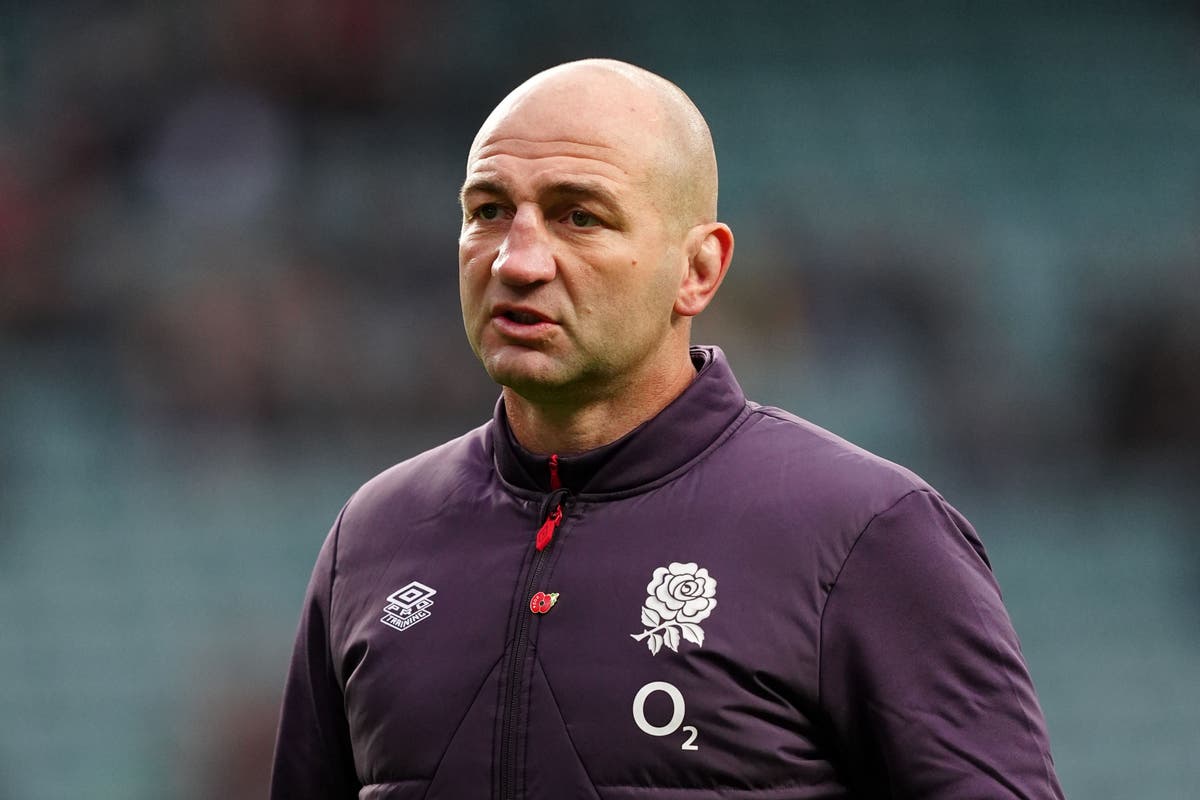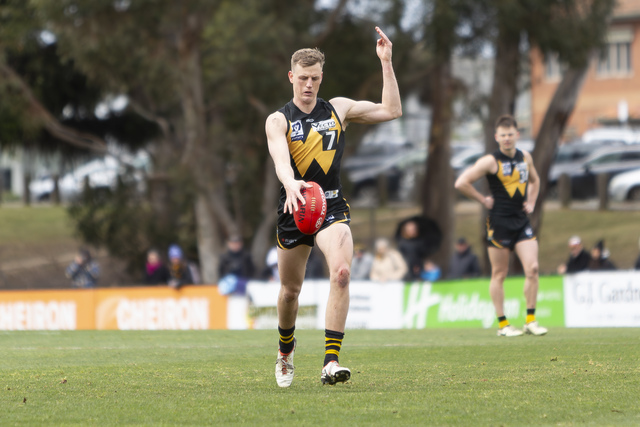‘It’s the lighter ball that’s doing it’: AFLW champion says women should trial the heavier ball

- by Admin
- October 31, 2024
When North Melbourne AFLW captain Emma Kearney was growing up in country Victoria, she didn’t have a choice but to play sport. It was, as she says, just “part of the culture”.
But for the now premiership player and eight-time All Australian, footy was not an option back then so she focused on cricket instead.
Emma Kearney, pictured beside her father, says she loved bowling out boys in cricket matches. (Supplied)
“There might have been three girls in the area that played cricket. Didn’t bother me. I loved it,” said Kearney, who ended up at the Melbourne Stars in the WBBL before choosing to focus on footy.
“I’ve got mad white line fever, so I used to love bowling out boys and probably giving them a send off.”
It wasn’t until she was studying for her teaching degree at university that she picked up footy again, joining Melbourne University in the state league in 2010 – seven years before the AFLW’s first season.
“When I first started playing [as a kid], there’s no way that I ever thought that I would be an AFL player,” Kearney said.
“I was mad [about] Essendon growing up. I always dreamt of representing the club and running around on the MCG. But I knew that wasn’t going to be a reality when I was younger.
To captain her football side in a national competition means a childhood dream coming true.
“That’s really special … I know young little Emma would be pretty happy to see that right now.”
A young Emma Kearney in the 90s wearing Bombers colours. (Supplied)
Emma Kearney (second from left) has captained North Melbourne since the club’s AFLW inception in 2019. (Dylan Burns AFL Photos)
‘Still a long way to go’
The league has come a long way in just under a decade, with the competition undergoing a rapid expansion since its inaugural season in 2017.
The league has ballooned from just eight teams to 18, with 11 rounds of football now played instead of seven.
Minimum player pay has also grown from $8,500 a year to a base salary of $56,077, pushing AFLW to become a more viable career path for many.
When the competition started, 60 per cent of players held full-time jobs outside of footy. That’s now dropped to just 16 per cent, according to the AFL Players’ Association.
AFLW has grown quickly in both size and in professionalism since it first launched in 2017. (AAP: Joel Carrett)
“I didn’t think it was going to progress this fast,” said Kearney, who quickly added: “But we’ve still got a long way to go”.
The Kangaroos skipper said clubs should be held accountable if they’re not supporting their women’s programs to the best of their ability.
“If we get even more coaches involved – really good quality coaches at grassroots level – we’re going to better the talent pools because there are other codes that will try to steal our talent,” Kearney said.
“Just like we’ve been trying to steal talent from other codes. The Matildas have been a prime example … I’m sure there’s plenty of people being inspired by them [and] the women’s cricket team, netball, the Opals in the basketball.”
Kearney was herself at the centre of a clash between sports codes in 2016, as cricket administrators attempted to have players commit to cricket over football.
Emma Kearney courted controversy early in her career as a dual-sports player with both the Melbourne Stars cricket team and the Western Bulldogs football team. (AAP: Joe Castro)
How condensed seasons push AFLW players to the limit
One of the main sticking points this season has been the condensed fixture, with 11 rounds squeezed into 10 weeks, resulting in teams playing games with short turnarounds.
Essendon had five games within 19 days, the Western Bulldogs played four games within 14 days and North Melbourne played three games within nine days, with Kearney suffering a hamstring strain during the second.
It was Kearney’s first soft tissue injury in her nine season football career, sidelining her for an expected six weeks. A “frustrating” injury, she noted, as that’s half the season in the women’s competition, while the men’s season goes for 24 home-and-away rounds.
“The condensed fixture has been quite challenging on clubs,” Kearney said.
“From a physical point of view, it’s been hard on our bodies trying to get up for each game in such short amount of breaks … whether it was a factor in my injury? Who knows.
“Obviously, being 35 and having to play three games in a short amount of time probably contributed somewhat.”
Emma Kearney says the condensed fixture puts increased pressure on players. (ABC News: Matthew Holmes)
Kearney added that it put an extra strain on people who work part-time or have other jobs outside footy, including some players, such as midfield stars Jasmine Garner (construction) and Ash Riddell (teacher), assistant coaches and support staff.
She said they found it “quite challenging” to juggle their commitments outside of football during that period.
“I can only speak from a Kangaroos perspective. The three of our games in that condensed period were played in the wet – two in torrential rain. So in terms of fatigue and being able to produce the best we possibly can, it probably was impacted somewhat.”
North Melbourne battled Port Adelaide in torrential rain in September. (Daniel Pockett AFL Photos)
Speaking on Channel 7 earlier this week, AFL executive general manager of football Laura Kane conceded the condensed fixture had been unpopular, but defended the midweek competition.
“You might see a midweek game next year, but when do you play your next one? We’ve heard the feedback on that one pretty clearly,” she told Seven’s Talking W program.
Ms Kane said the league was “definitely considering” an earlier start to the 2025 AFLW season.
‘More free-flowing, faster pace’: How AFLW is changing
One of the main public criticisms of the AFLW is that it’s low-scoring, contributing to a less enjoyable fan experience.
Kearney said there are a lot of contributing factors to this, including the women playing with a smaller ball (size four) than the men (size five), making it harder to kick as far.
She said when former North Melbourne veteran Hugh Greenwood did a session with the women’s team, he wondered why all his kicks were dropping short.
Emma Kearney says the small ball size affects the distance it travels after being kicked. (AAP: Joel Carrett)
“He realised that it’s actually the lighter ball that’s doing it,” Kearney said, adding that she’d love the AFL to trial a bigger ball in the women’s game.
And there are other factors that determine scoring.
“The quarters are shorter, we only have 16 on the field, as opposed to 18, yet we’re playing on the same size field.”
Then there’s coaching tactics too. Notably, Kearney is a development coach in Alastair Clarkson’s coaching group for the men’s senior side.
“Defence is far easier to coach than offence at times, and so we’ve seen teams play a bit more defensive style,” Kearney said.
But she thinks that’s changing.
“Because of the likes of Brisbane and Adelaide and even North Melbourne, the way that we’re playing is a bit more free flowing, faster pace. Hawthorn is another prime example … they’re playing a really attacking brand of football that’s really enjoyable to watch.”
AFLW games are played on the same size ovals as in the men’s games, despite having two fewer players on the field. (Dylan Burns AFL Photos)
The Western Bulldogs and Essendon received flack from the media and fans for their defensive tactics in week seven, where the Bulldogs scored just three behinds and the Bombers three goals.
However, that same week, North Melbourne booted 14 goals against Sydney, and Hawthorn kicked 11 against West Coast.
New talent poised to transform the league
Another way the game is rapidly changing is that draftees coming in have had an uninterrupted path into professional footy, unlike older players such as Kearney, who couldn’t play in her teenage years.
“In the women’s game, the ball spends a lot more time on the ground than it does in the men’s because of the skill levels. These younger players coming through are a lot cleaner at ground level,” Kearney said.
“I played sports that were above my shoulders – netball, tennis, basketball. I’m not used to the ball being on the ground a lot like the other players that are in the league at the moment.”
Dozens of AFLW hopefuls tested their skills at the recent draft combine. (Dylan Burns AFL Photos)
Another shift underway in the AFLW is an increase in professionalism across the competition.
All clubs now have training sessions during the day, giving them more time to work on their craft with coaches more readily available.
However, Kearney would love to see more full-time coaches within the AFLW, including in development and assistant roles. On top of this, the league would benefit from better investment in resources such as higher level medical and conditioning staff.
“The professionalism of the playing group is going up but I don’t think it’s being matched with the coaches, unfortunately,” Kearney said.
Kearney said many AFLW coaches were under strain fitting their part time coaching roles around full time work in other industries.
Clubs predict an influx of new talent into AFLW will rapidly change the league. (Dylan Burns AFL Photos)
A wish list for the next five years of AFLW
At the top of Kearney’s wish list for the next five years of the AFLW would be the ability to play 17 games each season so each team could play each other once.
“It would certainly take out the arguments of who’s got a really soft fixture versus who’s got a pretty hard fixture. It just means for an even competition,” she said.
Then, Kearney would like the league to work out when exactly to schedule the season. AFLW used to be played over the summer but now commences in the men’s pre-finals bye round.
Kearney said running alongside the men’s competition with at least a 17-round season would provide the opportunity for double headers.
While she wants the league to be professional she doesn’t want it to operate the same way as the men’s competition.
North Melbourne made it to the AFLW grand final last year, but came up short against Brisbane. (Josh Chadwick AFL Photos)
“The men have probably skewed too far in that they are athletes and athletes only. There’s a few players that will do some studying here and there, but it’s really challenging once those players retire from the game.
“The men’s can really learn from the women’s in that we can still be professional athletes, but if we’ve got time to do some part time work or study alongside that, I think that’s really important because we need to set up our athletes for when they leave the game.”
Now a hard question. Who does Kearney think will win the premiership this year? Her team, North Melbourne, are heading into the final home-and-away round undefeated and top of the ladder.
“I hope it’s us … I’m really happy with how the season’s going and we’re playing good football, but it’s going to be tough.”
And as for little Emma? She’s just happy she gets to call herself an AFL player.
The Latest News
-
November 15, 2024Red Dawn: Australian Football League’s Gold Coast Suns Launch ‘Fearless’ New Brand, Logo
-
November 15, 2024Kyrgios confirmed to return to ATP Tour at Brisbane International 2025
-
November 15, 2024Australian bounce India’s arch-enemy amid KL Rahul dilemma
-
November 15, 2024Nick Kyrgios set to make long-awaited return to tennis as comeback date revealed
-
November 15, 2024List wins elusive DP World Tour card, Barron loses his




